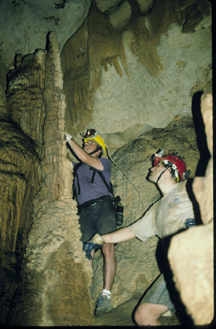
Geotimes Home | AGI Home | Information Services | Geoscience Education | Public Policy | Programs | Publications | Careers

 A stalagmite
mined from an island cave in the Indian Ocean suggests that the ages currently
assigned to the gold standard of ancient climate records — the Greenland
ice cores — need revision for the period between 55,000 and 42,000 years
ago.
A stalagmite
mined from an island cave in the Indian Ocean suggests that the ages currently
assigned to the gold standard of ancient climate records — the Greenland
ice cores — need revision for the period between 55,000 and 42,000 years
ago.  |
Geotimes Home | AGI Home | Information Services | Geoscience Education | Public Policy | Programs | Publications | Careers |